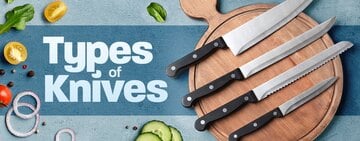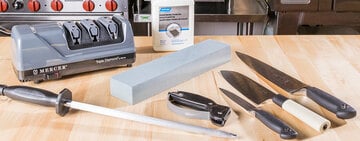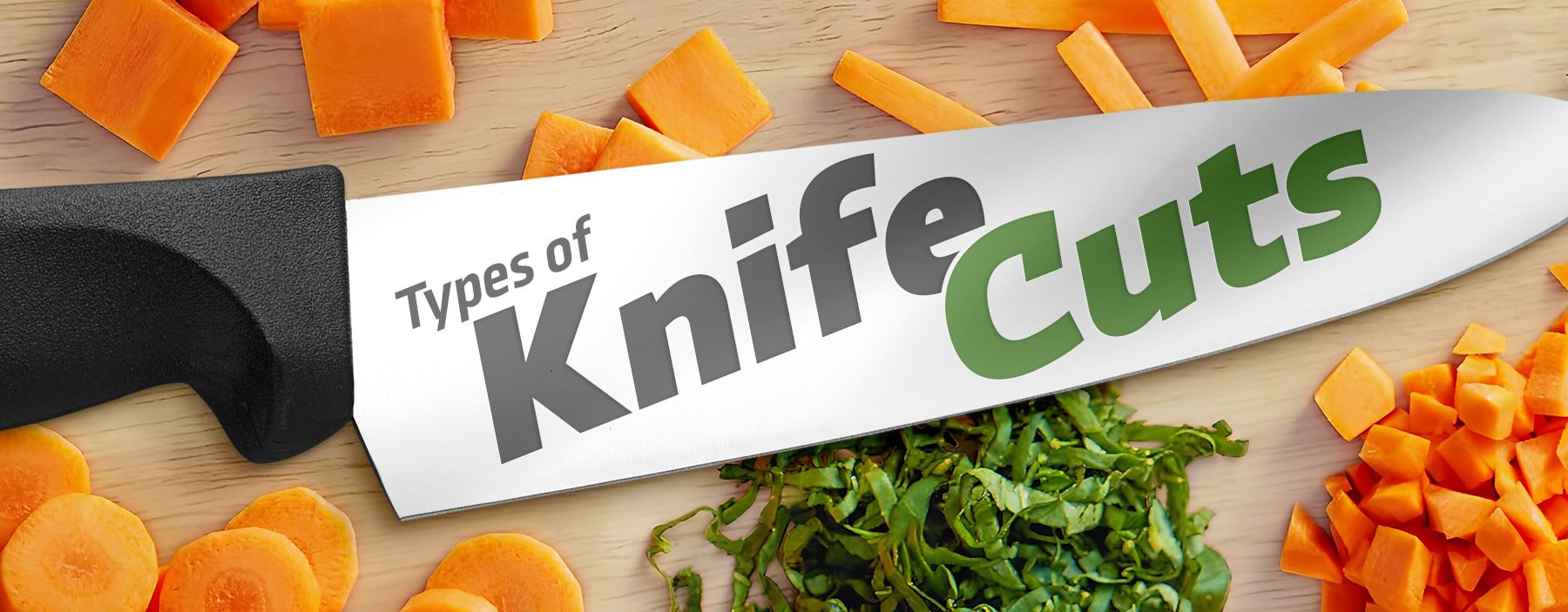
Restaurant kitchens write their recipe cards with the knife cut sizes in mind, so you must learn how to perform the classic culinary knife cuts to become a chef. Skillful knife cuts aren’t just about presentation; they ensure food cooks evenly, enhance texture, and release aroma. Whether you’re considering attending culinary school or want to move up the kitchen hierarchy, use our types of knife cuts guide to brush up on the basics.
Knife Cutting Techniques
Different Knife Cuts
Discover the essential knife cuts used in the culinary arts. From functional to decorative, each of these different knife cuts plays a role in creating a delightful mouthfeel and enhancing the flavor of your dish. To protect your hands, work with a well-sharpened knife and follow knife safety best practices as you master the different knife cuts.
1. Dice
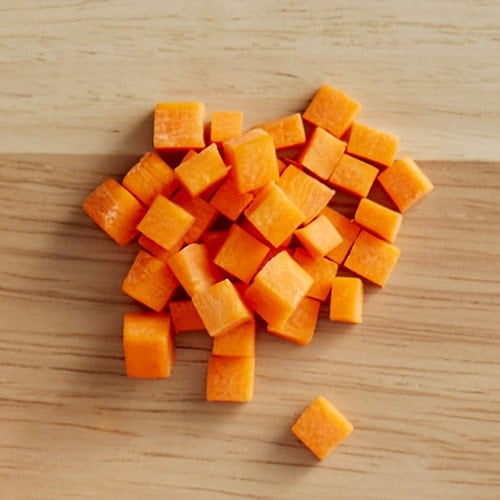
One of the most popular knife cuts, dicing, creates small blocks (aka “dice”) out of food items. There are three sizes of dice cuts: small dice, medium dice, and large dice. Small dice are foods cut into 1/4 x 1/4" cubes, medium diced items are 1/2 x 1/2" cubes, and large diced items are 3/4 x 3/4" cubes. Diced foods cook evenly and are aesthetically pleasing.
- Dice Cut Definition: The dice cut creates super-fine, consistent, and neat cubes.
- Dice Cut Size: The dice cut sizes are 1/4 x 1/4" for small dice, 1/2 x 1/2" for medium dice, and 3/4 x 3/4" for large dice.
- What Does the Dice Cut Look Like? The dice cut looks like small, cubed pieces.
- What Is the Dice Cut Used For? The dice cut is used for stir-fries, soups, and stews.
How to Dice
Follow these simple steps to easily dice almost any item.
- Wash and dry your vegetables before dicing them. You should peel most vegetables before cooking them, so peel your produce if necessary.
- Evaluate your item and see if there is a flat side you can rest against the cutting board for stability.
- Slice the entire vegetable into round steaks according to the size of dice you want to create.
- Slice the rounds into sticks (known as batons). Stack a few rounds together to expedite the baton-making process.
- Bundle the batons together and slice them horizontally to create cubes of your desired dice size.
2. Julienne
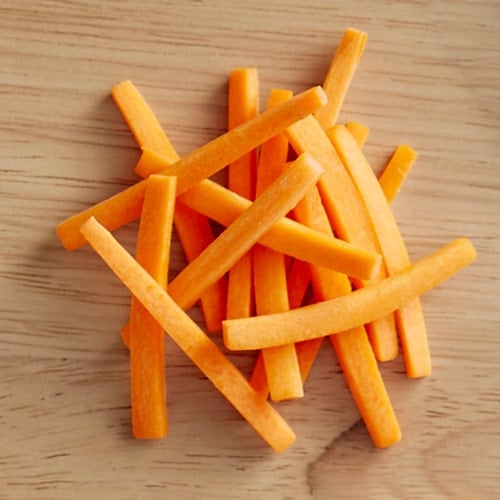
The julienne cut, also known as matchsticks, are thin, evenly and meticulously cut planks. Introduced in the French cookbook "Le Cuisinier Royal" in 1772, the julienne cut is a timeless element of classical French cuisine. It ranges in size between 2" and 3" long and 1/16- and 1/8" thick. To achieve the julienne cut, you must work with a high-quality utility knife with a well-sharpened blade. The julienne cut works best on firm produce like root vegetables, apples, and carrots.
- Julienne Cut Definition: The julienne cut is a method of slicing food items into matchstick-shaped sticks.
- Julienne Cut Size: The julienne cut is 2-3" long and 1/8" wide.
- What Does the Julienne Cut Look Like? The julienne cut looks like thin, even planks.
- What Is the Julienne Cut Used For? The julienne cut is used for extra crispy fried potatoes, adding apples and vegetables to salads, and vegetables for Asian noodle stir-fries.
How to Julienne
Follow these steps for the classic way to julienne foods:
- Make the produce rectangular by cutting off any rounded ends.
- Slice the vegetable into 1/8" thick planks.
- Stack the planks and then slice them lengthwise into 1/8" strips.
- Trim the 1/8" x 1/8" strips so their length is between 2-3".
Short Cut Julienne
While the method above is traditional, you’ll waste a lot of the vegetable by squaring it off. Try this shortcut to reduce food waste and save on prep time. Shortcut julienned pieces will be slightly pointed at the base compared to vegetables cut using the classic method. However, the pointed edge can add visual appeal.
- Slice your vegetable on an extreme bias into 1/8" planks.
- Stack the 1/8" planks and cut them lengthwise into 1/8" sticks.
3. Mince
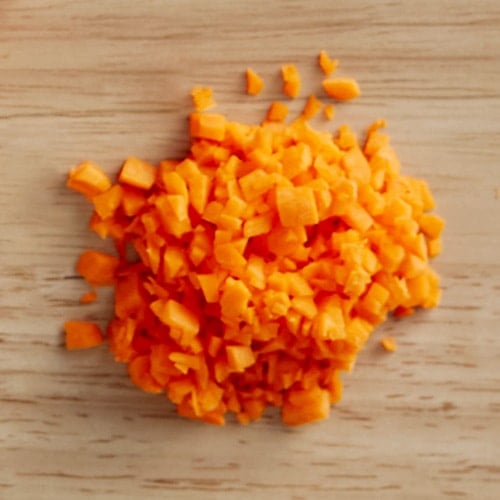
At just 1/16 ", mincing is the smallest knife cut size without chopping food into a puree or pulp. Aromatic root vegetables like ginger and garlic are the most popular candidates for mincing. Minced vegetables are often used as a seasoning or added to stir-fries and soups where their flavors distribute evenly. Minced aromatics practically dissolve when sauteed, leaving behind their strong flavor and aroma. Additionally, chefs mince their garnishes to create artful plating presentations.
- Mince Cut Definition: Mincing is the finest level of dicing and creates the maximum flavor dispersion.
- Mince Cut Size: The mince cut size is 1/16".
- What Does the Mince Cut Look Like? The mince cut looks almost granular.
- What Is the Mince Cut Used For? The mince cut is used to prepare aromatics for seasonings, stir-fries, and soups. Garnishes are minced for plating presentations.
How to Mince
While these steps can be used on any vegetable, we’ve chosen to explain the mincing process with carrots. Carrots are the standard vegetable culinary schools use to teach knife skills.
- Start by julienning your carrots.
- Form your fingers into a claw and anchor the julienned carrots to the cutting board.
- Slice the julienned carrots into the smallest pieces you can achieve, aiming for 1/16". Retract your fingers as you slice.
- If desired, run your knife through the carrot pieces to make them even smaller.
4. Chiffonade
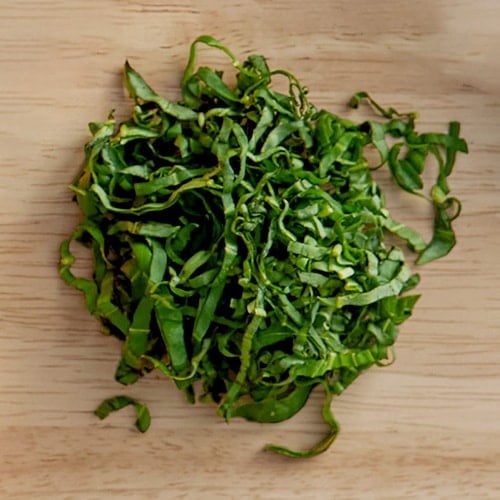
Chefs use the chiffonade knife technique to cut leafy greens and aromatic herbs into long, thin strips. The official translation for the French word chiffonade is rags, but don’t let that deceive you. The chiffonade knife cut creates beautiful curling strips that resemble ribbons. Garnish pizzas and pasta with ribbons of basil or create a gourmet salad by cutting different types of greens in the chiffonade style.
- Chiffonade Cut Definition: Chiffonade is a French cooking technique for slicing herbs and leafy green vegetables into long, thin strips.
- Chiffonade Cut Size: The chiffonade cut creates 1/8" strips.
- What Does the Chiffonade Cut Look Like? The chiffonade cut looks like ribbons of leafy greens.
- What Is the Chiffonade Cut Used For? The chiffonade cut is used for garnishing pasta, topping pizza, and creating artful salads.
How to Chiffonade Cut
- Wash and dry the leafy greens.
- Lay them flat on top of each other on your cutting board.
- Roll your stack of greens together.
- Slice your greens widthwise.

Cut through your greens quickly to minimize bruising and discoloration.
5. Chop
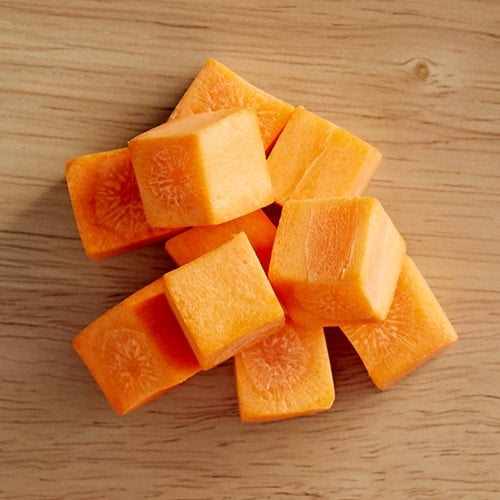
Chopping is slicing vegetables into small pieces of the same relative size, making it the easiest knife cut. Chefs rely on the fast and simple chopping method for recipes where the appearance and texture of the ingredients don’t matter. The classic cooking base, mirepoix, and purees use chopped vegetables.
- Chop Cut Definition: When it comes to cooking, chopping is a generic term for cutting bite-sized pieces of food.
- Chop Cut Size: The chop cut size is self-determined.
- What Does the Chop Cut Look Like? The chop cut looks like non-uniform, relatively even-sized pieces.
- What Is the Chop Cut Used For? The chop cut is used for mirepoix and preparing ingredients for pureeing.
How to Chop
- Wash and dry the produce.
- Peel them if necessary.
- Decide how large you want your pieces to be.
- Cut the produce into similarly sized pieces.
6. Brunoise
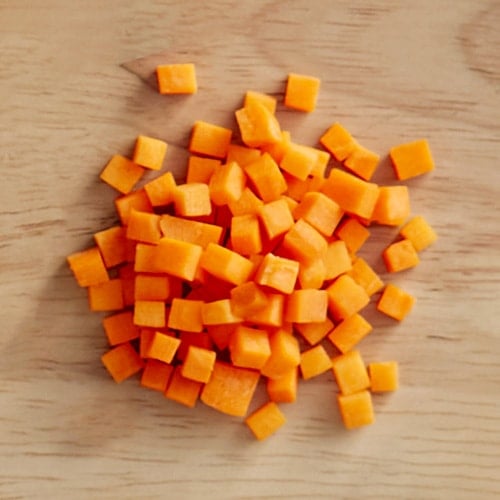
Brunoise is a French word that translates to tiny cubes, and it is the smallest cubed knife cut. An offshoot of the julienne, chefs set their julienne pieces side by side and then dice them into 1/8" cubes. Precision is key, or your brunoise cut will become a mince. Chefs favor the brunoise cut for their soups, stews, and stocks, but also use it to create garnishes.
- Brunoise Cut Definition: The brunoise cut is the smallest form of the dice cut and is derived from the julienne cut.
- Brunoise Cut Size: 1/8 x 1/8".
- What Does the Brunoise Cut Look Like? The brunoise cut looks like tiny cubes.
- What Is the Brunoise Cut Used For? The brunoise cut is used for soups, stews, stocks, and garnishes.
How to Brunoise
- Start with a julienne cut item.
- Cross-cut the julienne horizontally into 1/8" equal-sided cubed pieces.
7. Rondelle
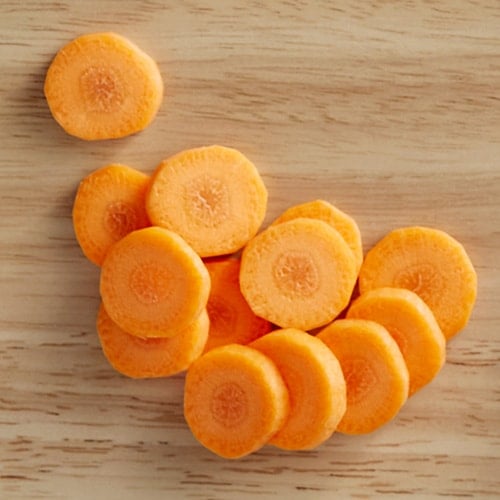
Rondelle, which means round, are coin-like pieces cut from cylindrical or conical vegetables. It is one of the easiest classic knife cuts to achieve. Typical candidates for the rondelle cut are cucumbers, carrots, zucchini, and eggplant. Because rondelle mirrors the shape of the product, there aren’t precise dimensions for this cut. However, the rondelle pieces must be uniform and have the same thickness. Most chefs cut their rondelle slices between 1/8 to 1/2" thick. Produce cut into the rondelle shape is perfect for roasting, sauteing, and raw consumption.
For variety, you can adjust how you perform the rondelle cut. Achieve coin-like rondelle pieces by slicing your vegetable straight. If you want to create an oval rondelle cut, slice the vegetable on a 45-degree bias. For a pretty plating presentation, use a channel knife to carve 6 stripes along the length of your vegetable before slicing it to yield star-shaped pieces.
- Rondelle Cut Definition: The rondelle cut slices round or oval-shaped food items into coin-like pieces.
- Rondelle Cut Size: The rondelle cut is 1/8- to 1/2" thick and its height corresponds to the product it's cut from.
- What Does the Rondelle Cut Look Like? Depending on whether you cut it straight or on a bias, the rondelle cut looks coin-like or oval.
- What Is the Rondelle Cut Used For? The rondelle cut is used for vegetable roasts, sauteed vegetables, veggie trays, and salads.
How to Rondelle Cut
Follow these steps to achieve the rondelle knife cut:
- Wash your produce and peel it (if necessary).
- For round rondelle slices, cut the vegetable straight down into uniform circles of your desired thickness (between 1/8 and 1/2").
- For oval rondelle slices, cut your vegetable at a 45-degree angle into your desired thickness (between 1/8 and 1/2").
- For decorative rondelle slices, use a channel knife to carve stripes into your vegetable before slicing it.
8. Batonnet
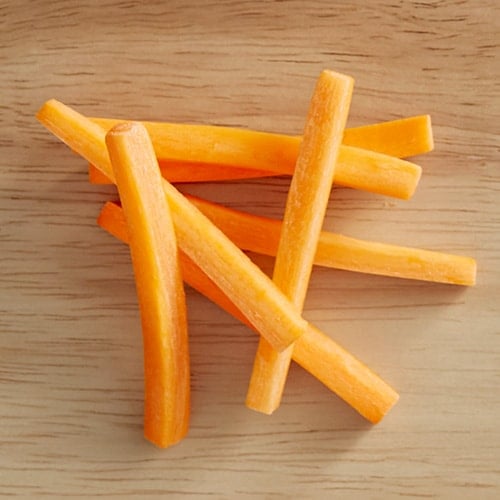
The batonnet cut, which means baton or stick in French, produces thick, rectangular vegetable sticks. The measurements for the batonnet cut are 1/4" x 1/4" by 2 to 2-1/2". Chefs favor the batonnet cut for vegetable presentations since they’re easier to handle and hardier than the classic julienne cut. Slice your vegetables into an attractive batonnet shape to elevate your charcuterie board or slide batonnet sticks into a charcuterie cone for a trendy, portable appetizer.
- Batonnet Cut Definition: Batonnet is a French term that translates to small stick, so when chefs use the batonnet cutting method, they are slicing food items into small, square sticks.
- Batonnet Cut Size: The batonnet cut size is 1/4" x 1/4" x 2-2-1/2".
- What Does the Batonnet Cut Look Like? The batonnet cut looks like thick, squared sticks.
- What Is the Batonnet Cut Used For? The batonnet cut is used for charcuterie boards, French fries, stir-fries, and veggie platters.
How to Batonnet Cut
- Cut off both ends of the item (this is known as topping and tailing).
- Form the item into a rectangle by squaring off its sides.
- Cut the rectangular item lengthwise into 1/4" slabs.
- Stack the 1/4" slabs and slice them into 1/4" strips.
- Trim the strips to achieve a length between 2-2-1/2".
9. Paysanne
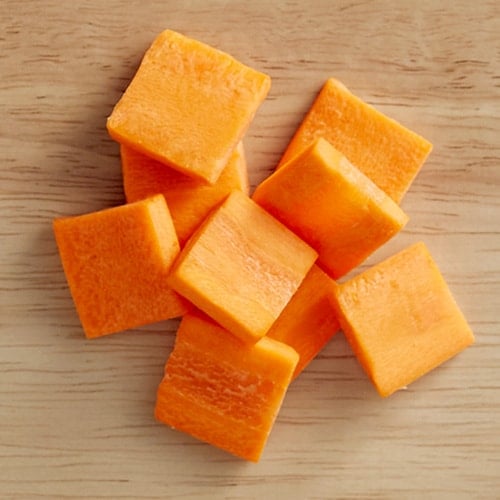
Chefs use the paysanne cut to create thin slices of vegetables that mirror their natural shapes. Paysanne is a French term that translates to country-style because it is less precise than other knife cuts used in classic French cooking. The paysanne cut size is 1/2 x 1/2 x 1/8".
- Paysanne Cut Definition: Paysanne, which means country-style in French, is a cutting method used to slice thin, naturally shaped food pieces.
- Paysanne Cut Size: The paysanne cut is 1/2 x 1/2 x 1/8".
- What Does the Paysanne Cut Look Like? The paysanne cut looks like thin slices of produce that mirror its natural shape.
- What Is the Paysanne Cut Used For? The paysanne cut is used for dense soups and thick stews.
How to Paysanne Cut
Since the paysanne cut mirrors the natural shape of the food item, how you’ll use the paysanne cut depends on the vegetable you’re slicing. Paysanne is often used to cut different types of potatoes, carrots, onions, and celery. In our example below, we explain how to paysanne cut carrots.
- Cut the carrot in half.
- Cut the thinnest part of the carrot lengthwise into four pieces.
- Place the four pieces together and position your fingers in a claw atop them, anchoring them to the cutting board.
- Slice the carrot pieces into small triangles, retreating your clawed fingers as you slice.
- Slice the thick, second half of the carrot in half, lengthwise. Then, slice the halved pieces lengthwise into 3 long pieces.
- Place the 6 long pieces next to each other.
- With your hand in a claw, anchor the carrot pieces to the cutting board and slice them into small pieces. Like before, retreat your clawed fingers as you slice.
- Repeat with as many carrots as necessary for your recipe.
While it takes more time, using culinary knife cuts will ensure your dishes cook correctly and create a professional presentation. Sharpen your knives, grab a cutting board, and start practicing the different knife cuts. You can always refer back to this guide whenever you take on a new recipe.



